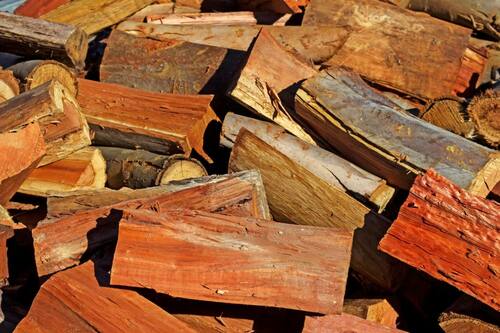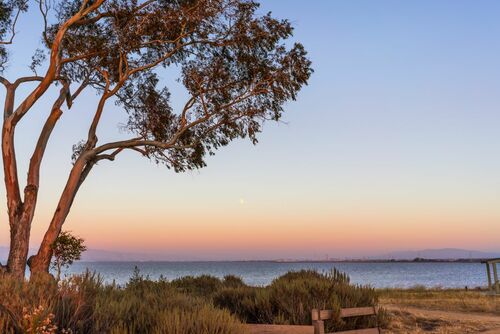Repurposing Eucalyptus: Exploring Sustainable Outdoor Uses for Bay Area’s Invasive Beauty
Introduction
The eucalyptus species is popular in the San Francisco Bay Area, yet it has its fair share of critics. In total, there are 40,000 eucalyptus trees on the planet. There are also 700 unique species of the plant. The strong and versatile eucalyptus is distinct in that it can reproduce without significant effort.
Eucalyptus trees disperse widespread seeds and also prove resistant to pests. It is even possible for eucalyptus trees to reproduce by merely placing one of its twigs or branches into the ground.
Though there is the potential for eucalyptus trees to grow beyond their intended limits, these trees are not as problematic as most assume. In short, the eucalyptus tree gets a bad rap as being highly invasive to the point of destruction. This is your guide to San Francisco’s iconic eucalyptus, highlighting its unique story. We also touch on sustainable repurposing of invasive plants for increased utility.
The Story of the Eucalyptus in the San Francisco Bay

A Large Eucalyptus Tree Growing in the San Francisco Bay Area
The eucalyptus tree, native to Australia, was introduced to the SF Bay Area in the mid-19th century. The tree was first planted during the state’s famous Gold Rush. The tree quickly became prominent throughout the Bay despite the fact that it isn’t native to the area.
The eucalyptus was critically important for the generation of building materials that supported the California Gold Rush. The era required affordable wood for the construction of infrastructure.
Walk around the San Francisco Bay area and you’ll find eucalyptus trees are widespread, artfully ornamenting the commercial and residential landscapes of one of the nation’s most beautiful cities. One of the best-known eucalyptus trees in the area is planted in the Presidio’s Sixth Army Parade Ground. This famous blue gum was planted in 1876 to commemorate the centennial of the nation.
Head over to the Mountain View Cemetery and you’ll spot some gorgeous eucalyptus trees. The cemetery was designed by none other than Frederick Law Olmstead. The cemetery’s trees are highlighted by the iconic blue gum eucalyptus tree.
The Environmental Impact of the Eucalyptus Tree
The eucalyptus is inherently invasive, meaning it is inclined to grow freely thanks to its extensive seed dispersal. The eucalyptus also has some positive features, primarily in the form of its beauty and functional use. Research the eucalyptus in depth, and you’ll find it makes a significant impact on local ecosystems including that of the San Francisco Bay area.
Eucalyptus trees are essential for the production of the following industrial and consumer products:
Eucalyptus trees sprinkle seeds through the wind that spawn even more tree growth and continued expansion in suburban and urban spaces throughout San Francisco. Though the tree’s leaves present a slight danger to soil, the benefits ultimately outweigh the slight risk.
Let’s take a quick look at how the eucalyptus tree is used for commercial purposes in San Francisco and beyond.
Eucalyptus Wood Uses

Chopped Eucalyptus Wood
Eucalyptus wood is highly functional, providing utility for commercial and consumer products including decking, furniture, and even the structures that comprise some San Francisco gardens. It is the unique properties of the tree’s wood that make it ideal for use in such outdoor projects.
Take a look at the outdoor furniture at your local stores and you’ll find eucalyptus and teak are the two most common wood variations. Eucalyptus wood is considered a hard wood, although its density and hardness differ based on species.
In general, the wood of eucalyptus is not as dense or as hard as other wood variations. The eucalyptus wood’s lovely mahogany, dark-red, and pale-yellow hues are also ideal for outdoor furniture, including garden pieces that complement greenery.
Eucalyptus wood is also essential for outdoor construction thanks to its natural weather resistance. The wood’s all-natural resistance to weather is primarily the result of its internal oils. However, the wood needs a little bit of maintenance to remain durable when nasty weather strikes.
An increasing number of San Francisco park and recreation facilities use the wood milled by Arborist Now . Arborist Now also works with landscape designers using eucalyptus for outdoor projects including garden structures and landscaping features.
Creative Eucalyptus Repurposing Strategies
The utility of eucalyptus wood allows for extensive repurposing. Eucalyptus wood is even repurposed as fabric that serves as a sustainable alternative to regular cotton. As an example, lyocell fabric comprises clothing made from eucalyptus trees. This fabric is said to be stronger, more wrinkle resistant, and blends easily with other materials so it can be used in a variety of different ways. Companies like Sheetz & Giggles use this fabric to make things such as pillowcases, bedsheets, and more.
Lyocell is made with a unique manufacturing process in which eucalyptus wood is chopped into small pieces and then ground until the point that it reaches a smooth pulp. The output is then washed, dried, and made into yarn to make fabric. Aside from clothing, the tree’s wood is also repurposed for furniture and construction.
The wood’s unique carbon separation prevents natural resource depletion. The tree adapts to its environment and even regenerates better than most others, allowing for continued use in other commercial purposes.
The repurposing of eucalyptus wood into furniture results in a surprisingly low carbon footprint, as the wood waste is recycled better than most other competing options. The trees are turned into lumber using sawing machines. The lumber is then dried before being made into furniture. Though there is the potential for lumber to be difficult to dry, and there is also the possibility of cracks and collapse, it eventually dries for repurposing.
Managing Invasive Species

The Leaves and Prolific Seed Pods of the Blue Gum Eucalyptus
The eucalyptus population in the Bay Area is strategically controlled and managed . The pest-resistance capability of 21 eucalyptus species in San Francisco was assessed between 1998 and 2000. The majority of the species were categorized as tolerant or resistant. Though some of the tree’s species were categorized as moderately susceptible, merely three of the species displayed significant defoliation and rated as either highly susceptible or moderately susceptible. The rating of the trees was determined through analysis of nymphs and eggs along with the frequency and severity of eucalyptus tree defoliation.
The trees analyzed averaged 10-15 years in age, meaning they had adequate time to expand their root systems and drop seeds in their vicinity. The overarching purpose of eucalyptus management is to ensure the trees do not allow fire to spread. Eucalyptus management also maintains the ecosystem and serves the purpose of historic preservation .
Eucalyptus management strategies can be as simple as removing the trees’ lower limbs. Other strategies include thinning and full stand removal. The typical eucalyptus management program consists of multiple phases for comprehensive trimming. If San Francisco eucalyptus stumps are left unaddressed, they will inevitably resprout, necessitating additional cutting. Herbicide is used to treat tree stumps. Some stumps are completely ground down.
Eucalyptus managers also tarp the stumps with heavy plastic to prevent resprouting using light deprivation and a barrier. Eucalyptus “slash” is the debris remaining after vegetation management including tree trunks, leaf litter and branches. The largest of remaining tree material is transported to landfills or composting sites and then cut into logs used for firewood.
The stumps are sometimes left in their current form for landscaping use. If the remaining material is a couple of feet in diameter, it can be chipped apart and distributed as mulch.
An Invasive Yet Useful Species

A Blue Gum Eucalyptus Overlooks The San Francisco Bay Area
Take a look at this invasive species the next time you stroll through the San Francisco Bay area, and reconsider the negative connotation of the word “invasive,” instead choosing to focus on its utility. The uses of eucalyptus wood are extensive: furniture, clothing, and garden structures give these trees value beyond mere aesthetics.
In the end, there is no denying that the eucalyptus tree is somewhat of a nuisance, yet it is a net positive for San Francisco residents, local business owners, and others. The bottom line is that green timber eucalyptus trees are an invasive species, yet one with extensive benefits.
Frequently Asked Questions About Eucalyptus Trees
Q: Are San Francisco eucalyptus trees useful or purely ornamental?
A: Eucalyptus trees provide utility in several ways. The wood from the eucalyptus is used for outdoor furniture, clothing, and even garden structures. However, some San Francisco businesses and residential property owners use eucalyptus trees for pure ornamentation. These beautiful trees will likely be repurposed in new ways in the years ahead as product engineers develop new and creative ways to turn eucalyptus into functional items.
Q: Will the addition of a eucalyptus tree ruin my property?
A: Highly unlikely. Eucalyptus trees are somewhat of an invasive species in the Bay Area, meaning they are capable of spreading across your property, yet they are unlikely to ruin it. Eucalyptus maintenance limits tree growth to a certain extent, ultimately preventing a potential fire.
Q: What are the best reasons to plant a eucalyptus tree?
A: If you are tempted to plant a less invasive tree or shrub on your San Francisco property, take pause. Aside from visual beauty, eucalyptus trees are also beneficial for other reasons including utility. The eucalyptus is used for:
- Firewood
- Paper
- Biomass
- Furniture
- Cough remedies
The wood of the eucalyptus can even be used for fire pits and wood burners.
Q: Is there a reason why my eucalyptus tree is growing so quickly?
A: Eucalyptus trees generate shoots that catalyze growth. The tree’s leaves have buds that open in the springtime, unfold, and develop leafy shoots. Alternatively, if your eucalyptus tree in San Francisco is not growing as quickly as desired, water it more often than you currently are.
Q: Is it possible to move a eucalyptus tree after planting?
A: If the tree has not been growing for more than a couple of seasons, it will be challenging to transplant it without the right machines. Transplanting a young eucalyptus tree requires the pruning of the side roots and undercutting before the transition. Begin by creating a small circle within the soil that spans a foot in radius around the trunk . Water the plant for the next month to two months for adequate growth.
Q: Can the tree be planted next to my house, business or other building?
A: Yes. If you would like the plant to become a full-size tree, plant it away from your San Francisco house or other building. Make sure the tree is not overshadowed. It will also help to prevent weeds from infringing on the growing plant to maximize growth.
Q: Is there an optimal time to plant eucalyptus trees?
A: Yes. The best time to plant the tree is before winter. However, you can plant the tree year-round if desired.
We may receive affiliate compensation for some of the links below at no cost to you if you decide to make a purchase.


